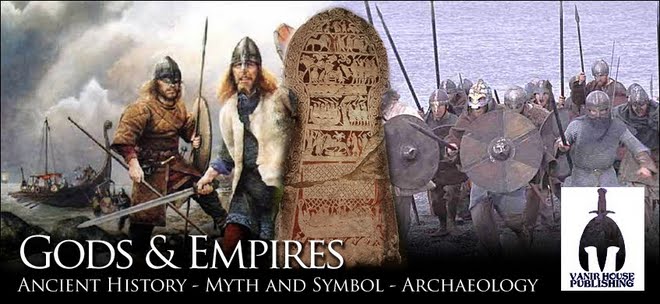
The Ancient American, Volume 1, Issue 6
By Carol Bass
An unusual mound of stones in the shape of a ship which could date back to Viking settlements in the New World has been discovered in an area forest. History experts who have visited the site suspect the 65-foot stone structure may be a large “cairn,” an ancient European burial site constructed for the dead by the Viking and Celtic cultures. The exact location of site, which is in Windham County, is being kept under wraps to avoid the possibility of vandalism.
When first sighted through undergrowth, the ‘cairn’ appears to be just another short stretch of old New England stone wall, but on closer inspection, the boat shape of the stone pile becomes immediately apparent. The ‘cairn’ is close to 50 feet long and at its widest point measures 30-40 feet wide, and is four feet high. It is a near exact stone replica of a New England dory, a narrow at the bow and stern, with a very wide-mid-section. It is in fairly good shape and is only slightly damaged on one side where a growing tree has caused part of it crumble.
The structure was discovered by photographers Virginia and William Welch of Hampton. The couple saved it from near demolition by officials who have been planning to reforest the area. The state Department of Environmental Protection has now flagged the site to protect it for further observation and study.
The site has been viewed by several regional historical societies, including the Early Sites Research Society of Rowley, Mass., and the Gungywump Society of Noank. Officials from the societies agree that the site is ‘Nordic’ in nature, although no definitive conclusion has been reached about the origin of the artifact.
All who have viewed the site, however, agree with David Barron, president of the Gungywump Society, the structure is ‘very definitely not just a pile of stones. It was deliberately laid, deliberately set out, and has a deliberate plan to it.”
The Gungywump Society is a group of avocational archaeologists and historians who study historical phenomena throughout the state.
The mounds origins remain unknown now, although it is known that Vikings were in Canada. Barron said he wouldn’t suggest the mound is Viking in origin, because he said, “There is no evidence yet beyond the fact that it is unique and in the shape of a boat.”
Welch noted that the centerpiece of the structure, which he described as a ‘a slab that appears to have been standing,” resembles European burial places, or ‘cairns’.
This particular cairn, if that is what the structure is, is unusually large, according to Barron.
The presence of Viking in the New World before Columbus has been a debatable topic for years. It is agreed that the Vikings visited ancient Russia, the Black Sea, the Mediterranean, Iceland and Greenland.
Experts who have visited the Windham Country site are cautious to theorize about its origins. They all agree with Welch, however, that it is ‘something that appears to be very old. It’s an artifact that goes far beyond the English-Colonial period,” he said.
“Our main objective right now is to keep it low key Riggio said, “One of the problems we have today is that field, stone is in such high demand there pillaging of old stone walls and their stones get robbed every day.” Welch thinks the structure has at least ‘superficial similarities’ to European cairns which commemorate burial sits.”

